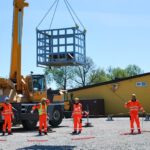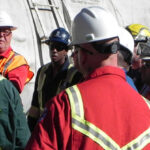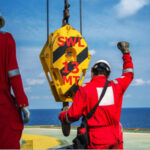
Risk assessment is crucial in lifting operations to ensure safety, prevent accidents, and comply with legal and regulatory requirements. Here are the key reasons why risk assessment is important in lifting operations:
- Prevention of Accidents and Injuries
Lifting operations often involve heavy loads, use of lifting equipment, and hazardous environments. A thorough risk assessment helps identify potential hazards (e.g., equipment failure, falling loads, or human error) and implement measures to mitigate them, reducing the likelihood of accidents and injuries.
2. Protection of Workers and Public Safety
Lifting operations can pose risks not only to workers but also to bystanders. Risk assessment ensures that safety measures are in place to protect everyone in the vicinity, such as using barriers, warning signs, or exclusion zones.
3. Compliance with Legal and Regulatory Standards
Many countries have strict regulations governing lifting operations (e.g., OSHA in the U.S., LOLER in the UK). Conducting a risk assessment ensures compliance with these laws, avoiding legal penalties and potential shutdowns.
4. Identification of Hazards
Risk assessment helps identify specific hazards associated with lifting operations, such as:
– Overloading cranes or lifting accessories.
– Poor ground conditions or unstable surfaces.
– Inadequate training of operators.
– Poorly maintained lifting equipment.
– Adverse weather conditions (e.g., high winds).
5. Improved Planning and Preparation
A risk assessment ensures that lifting operations are carefully planned, including selecting the right lifting equipment, ensuring proper training, and establishing clear communication protocols. This reduces the likelihood of errors during the lifting operation.
6. Reduction of Equipment Damage
Improper lifting operations can damage equipment, leading to costly repairs or replacements. Risk assessment helps prevent misuse of equipment and ensures it is used within its safe working limits.
7. Enhanced Communication and Coordination
Risk assessments often involve input from multiple stakeholders, including operators, supervisors, and safety officers. This fosters better communication and coordination, ensuring everyone understands their roles and responsibilities.
8. Emergency Preparedness
A risk assessment includes planning for potential emergencies, such as equipment failure or accidents. This ensures that workers know how to respond quickly and effectively, minimizing harm.
9. Cost Savings
By identifying and mitigating risks early, companies can avoid costly accidents, downtime, and legal liabilities. This contributes to overall cost efficiency and operational continuity.
10. Reputation Management
Accidents during lifting operations can damage a company’s reputation. Demonstrating a commitment to safety through thorough risk assessments enhances trust with clients, regulators, and the public.
Key Elements of a Lifting Operation Risk Assessment
- Hazard Identification: Identify potential hazards (e.g., load instability, equipment failure).
- Risk Evaluation: Assess the likelihood and severity of each hazard.
- Control Measures: Implement measures to eliminate or reduce risks (e.g., using certified equipment, providing training, establishing exclusion zones).
- Monitoring and Review: Regularly review and update the risk assessment to address new hazards or changes in operations.
Conclusion
Risk assessment is a fundamental part of ensuring safe and efficient lifting operations. It not only protects workers and equipment but also ensures compliance with regulations, reduces costs, and enhances overall operational effectiveness. Ignoring risk assessment can lead to severe consequences, including accidents, injuries, and legal repercussions.
Primelift Safety Resources Limited offers various trainings in rigging and lifting operations.
Call us on +234 9115687051. Email us on training@primeliftsafetyng.com
www.primeliftsafetyng.com










